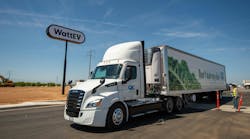WattEV continues to make charging infrastructure a non-issue along the West Coast
WattEV, a charging infrastructure developer for heavy-duty electric trucks, opened another charging facility along the West Coast in Bakersfield, California. The 119-acre facility, which WattEV claims is the first of its kind, features a solar-powered microgrid with a battery energy storage system and is capable of megawatt rapid charging.
“We're maybe the first to ever have a fully islanded set of charges that run on nothing but solar and battery storage,” WattEV CEO Salim Youssefzadeh told FleetOwner. “It's completely independent of the utilities.”
This is the third electric truck charging depot WattEV has opened in California in the past month. The opening of the Bakersfield facility completes the electrification of the CA-99 freight corridor connecting the agricultural region in the San Joaquin Valley to major ports, with more depots planned in Fresno, Stockton, and Oakland, according to a press release from the company.
See also: What are EV truck charging stations' needs?
WattEV’s first-of-its-kind heavy-duty EV charging station
The station features 15 single-cord 240kW direct-current chargers, plus three 1,200kW rapid megawatt chargers, all drawing power from the site’s solar array. For nighttime and overflow charging, this WattEV facility also includes 16 dual-cord 360kW chargers that are connected to the electrical grid.
Enabling megawatt rapid charging on the site will be a game-changer for those running heavy-duty EV operations. While it currently takes nearly three hours to charge trucks using today’s 240 to 360kW direct-current, rapid-charging technology, megawatt rapid charging brings down truck charging dwell time to less than 30 minutes, Youssefzadeh explained.
WattEV is the first to use megawatt rapid charging, standardized by Char-In, in a public setting.
WattEV strategically chose to build this facility in Bakersfield for multiple reasons. One was because it’s near potential customers with an Amazon distribution center, a large industrial park, and an agricultural community nearby, Youssefzadeh said.
Bakersfield also offers adequate space for WattEV’s solar energy needs, which “you can’t find in a densely populated area like the [charging facilities] we have in Long Beach and San Bernardino,” Youssefzadeh explained.
Finally, California’s San Joaquin Valley—where Bakersfield is located—is known for having poor air quality, and building heavy-duty charging infrastructure will help local businesses bring zero-emissions operations to their fleets, which is “a huge benefit to the entire San Joaquin Valley,” Youssefzadeh told FleetOwner.
The site—three years in the making—is located on 119 acres. WattEV dedicated 100 of those acres to solar panel space to feed its microgrid; the remaining 19 acres house a “traditional truck stop-style pad,” Youssefzadeh said, with a convenience store and additional amenities.
WattEV’s microgrid
Developing charging infrastructure takes time, from months to years, especially when the utility company is involved.
“We wanted to test if there's ways to go about [building charging infrastructure] without waiting that time,” Youssefzadeh said. “That's where microgrid came into play.”
California Energy Commission granted WattEV $5 million to build and test this facility, and the first phase of that funding is to test the microgrid and see how well it works for EV charging and whether it helps build resilience against grid outages or grid delays, Youssefzadeh said.
Only 25% of the 100 acres dedicated to solar panels is in use by WattEV today. This provides the WattEV station with five megawatts of solar power and three megawatt hours of battery storage that powers the 15 240kW chargers and the three megawatt chargers. The San Joaquin Valley Air Pollution Control District will help support future solar expansion, according to a WattEV statement.
Expanding charging networks and accelerating EV adoption
Today, WattEV has heavy-duty EV charging facilities open in Long Beach, San Bernardino, Gardena, and Bakersfield, and aims continue expanding. WattEV plans to open three more locations in California in 2024, including locations in Vernon, Blythe, and Moreno Valley.
Eventually, the company plans to have 16 public charging facilities along the West Coast, with large-scale solar-powered charging depots in the permitting stages in Blythe (on Interstate 10) and Sacramento, Gustine and Taft Highway (on Interstate 5), and Salem, Oregon, and Seattle-Tacoma, Washington (on Interstate 5).
Once WattEV completes its opening of these stations, electric commercial vehicle owners and drivers along the West Coast won’t be far from a WattEV charging station, no matter their location. The implementation of megawatt charging will also benefit area fleets. Youssefzadeh believes this should support the adoption of these heavy-duty electric vehicles.
See also: FirstElement brings heavy-duty hydrogen fueling capabilities to the masses
“Infrastructure is here,” Youssefzadeh told FleetOwner. “I don't think it's a valid excuse to say that there is no infrastructure to do [electric] routes. Now, it's just about getting trucks in the hands of the users and getting trucks in the hands of the owner-operators so that they can actually start moving freight with zero-emissions vehicles.”







